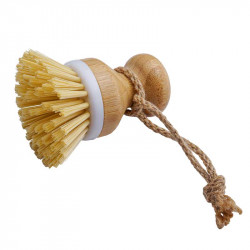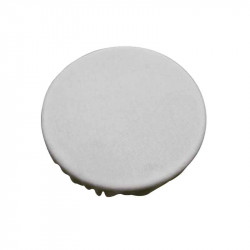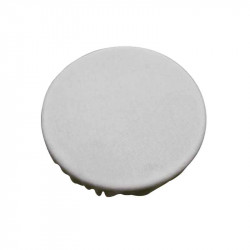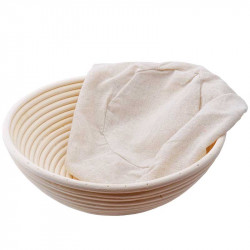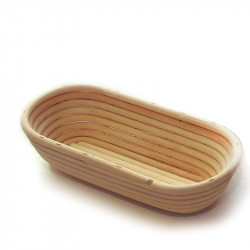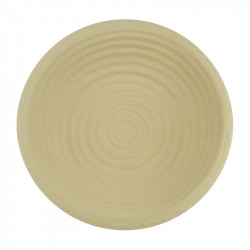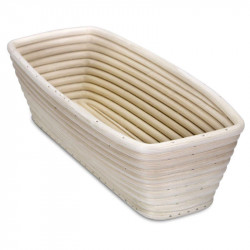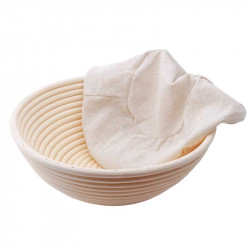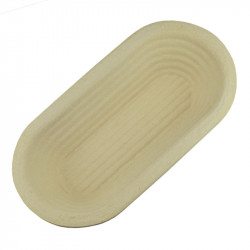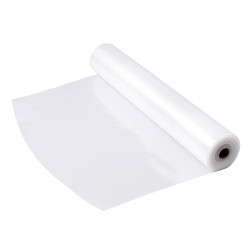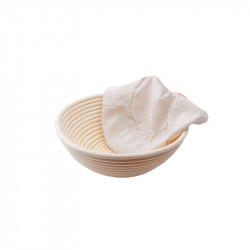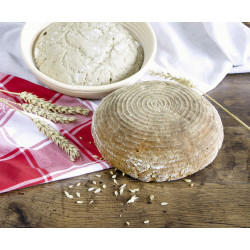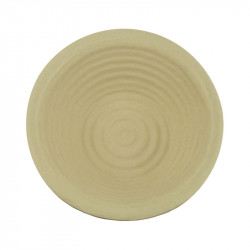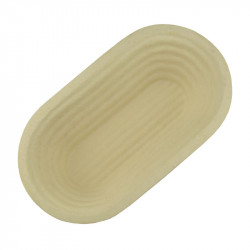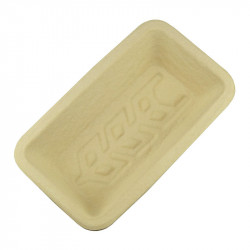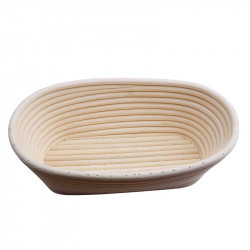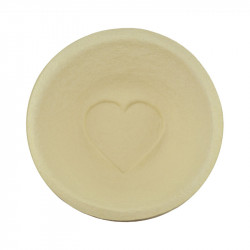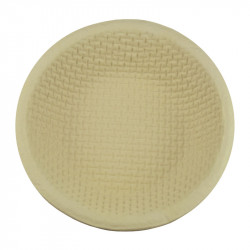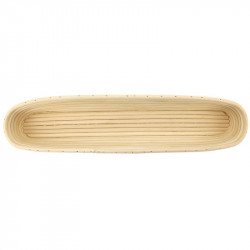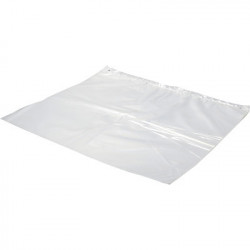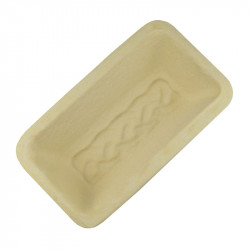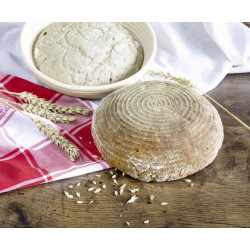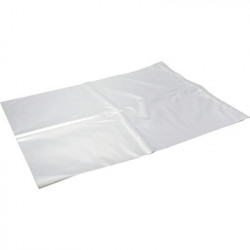Proofing basket
What is a proofing basket / proofing basket?
A proofing basket, also called a proofing basket or bread basket, is a tool used in baking bread. It consists of a basket or bowl lined with a fine-mesh fabric. This ensures that the dough does not stick to the surface of the basket.
The proofing basket is used to shape and support the dough during proofing and resting. It helps to maintain the perfect shape and structure of the bread while the dough develops its final rise. The proofing basket also helps form a beautiful, decorative surface texture to the bread.
The proofing basket is often dusted with flour before the dough is placed inside to prevent sticking. After proofing, the dough is carefully transferred from the proofing basket to the baking sheet or oven.
Proofing baskets come in different shapes and sizes, depending on the shape of bread you want to make. Popular shapes include round, oval or oblong. Most proofing baskets are made of natural materials such as peddigree cane or rattan and are usually easy to clean.
Why is it useful to use a proofing basket / proofing basket?
There are several reasons why it makes sense to use a proofing basket or a proofing basket when baking:
1. Shaping: A proofing basket is specially designed for resting dough and fermenting bread dough. The basket gives the dough the desired shape and ensures that the bread has a nice, even texture and a round or oval shape. It also prevents the dough from coming apart flat.
2. Even fermentation: The proofing basket allows the dough to ferment evenly by supporting and stabilizing it. The basket material (e.g. rattan or wood) absorbs moisture and regulates the moisture balance in the dough. This results in optimal fermentation and homogeneous poring of the bread.
3. Skin formation: The proofing basket promotes the formation of a crispy crust. The surface of the dough comes into contact with the basket material during the fermentation process, which leads to a slight drying out. As a result, a thin skin forms on the dough, which ensures a beautiful and crispy crust during baking.
4. Easy handling: The proofing basket makes it easier to handle the dough. The basket shape makes it easy to place the dough in the basket by hand and remove it from the basket after the resting time without it sticking or losing its shape.
5. Tradition and aesthetics: The use of proofing baskets also has a tradition in the bakery trade. Many bread lovers appreciate the traditional aspect and the aesthetic effect offered by a bread with a beautiful basket impression look.
Overall, the use of a proofing basket helps to give the baked bread an attractive shape, an even fermentation and a crispy crust. It is a useful tool for bakers and hobby bakers who value the quality and appearance of their bread.
What is the purpose of a proofing basket / proofing basket?
A proofing basket or proofing basket is a utensil used in bread and pasta making. It is used to shape and support the dough during the proofing process.
The proofing basket is usually made of a wickerwork of wicker, wood or plastic and has a round or oval shape. The dough is placed in the proofing basket where it can retain its shape and continue to rise. The basket weave also allows the dough to take on a beautiful pattern.
The proofing basket provides stability to the dough and prevents it from coming apart or losing its shape. It absorbs excess moisture and promotes good air circulation, resulting in even fermentation of the dough. The result is an evenly risen and well-shaped bread or pastry.
After fermentation, the dough can be removed from the proofing basket and baked. Some proofing baskets also have removable inserts that make it easier to remove the dough.
Overall, the purpose of a proofing basket is to assist the proofing process of the dough, to ensure a nice shape, and ultimately to obtain a high quality, evenly baked bread or pasta product.
What exactly is a proofing basket / proofing basket?
A proofing basket or proofing basket is a special container used in bread baking. It is a basket or bowl, usually woven from natural reeds or willow rods, in which the bread dough can rise for fermentation or even stabilization. The proofing basket has a porous surface that allows the dough to draw air as it rises. This gives the bread a nice shape and texture. Before the dough is placed in the proofing basket, it is often dusted with flour to prevent sticking. After the dough has risen, the bread can be carefully turned out of the proofing basket and then baked. The embossing of the proofing basket often allows decorative patterns to be achieved on the crust of the bread.
Which flour should you use for a proofing basket and why?
For a proofing basket it is best to use rye flour or wholemeal flour. These types of flour contain more proteins and enzymes than wheat flour, which is beneficial for the fermentation of the dough. In addition, rye flour absorbs more moisture, which means that the dough sticks less and the typical proofing basket structure is better preserved. Ultimately, the use of rye flour or whole wheat flour helps to improve the volume and fluffiness of the bread.
Where to buy proofing baskets and a proofing basket?
Proofing baskets and proofing baskets can be purchased at many different stores and online stores. Here are some options:
1. Specialized bakery supply stores: You can often find proofing baskets and proofing baskets in specialized bakery supply or kitchen supply stores. Search for such stores in your area for example at miniSchoggi you will find one of the largest selection of proofing baskets and proofing baskets for your bread. Inquire about their product offerings.
2. Online bakery supply stores: there are many online stores that specialize in selling bakery supplies. Examples include the large bakery store and online store of miniSchoggi in Adliswil.
3. Kitchen departments of large retail chains: Some large retail chains have a special department for kitchen utensils, where you may be able to find proofing baskets and proofing baskets.
Note that the availability of proofing baskets and proofing baskets may vary depending on the region. Therefore, it is advisable to check different stores and online stores to find the product you want.
Is a proofing basket necessary at all?
A proofing basket is not absolutely necessary, but it can help in the process of proofing dough. The proofing basket ensures that the dough keeps its shape while rising and does not fall apart. It helps develop a nice, even crust and also makes the bread look nicer. However, there are other methods to help the dough rise, such as letting it rise in a bowl with a floured tea towel. Ultimately, the use of a proofing basket is a matter of personal preference and aesthetics.
What material should a proofing basket or proofing basket be made of and what are the differences?
A proofing basket, also called a baker's basket or bread proofing basket, is used to stabilize bread dough during the proofing process and give it a nice shape.
The most common materials for proofing baskets are rattan, wood and linen.
Rattan is a natural material obtained from the stems of rotang plants. It is flexible, lightweight, and allows air to pass through it well, allowing the dough to ferment evenly. Rattan proofing baskets come in a variety of shapes and sizes and can also be used in the bakery or oven.
Wooden proofing baskets are made of wood pulp or plywood. They often have holes or slots that allow for good ventilation. Wooden proofing baskets are sturdy and ensure that the dough holds its shape while it ferments. They cannot be placed in the oven.
Linen proofing baskets are made of linen or cotton fabrics and are coated with a starch to prevent the dough from sticking to them. They are breathable and also suitable for the oven. Linen proofing baskets create a fine surface texture on the bread, which is highly desirable for many types of bread.
The choice of material depends on personal preference and the desired bread texture. Rattan and wood allow good air circulation and produce a slightly crispy crust, while linen produces a softer effect. Some people also prefer the look and feel of a particular material. It is also important to note that the choice of material does not affect the taste of the bread.
What is the purpose of a linen insert for proofing baskets and proofing baskets?
A linen insert for proofers and proofing baskets is used to support and shape the dough during the proofing process.
Here are some main functions of the linen insert:
1. Supporting the dough: The linen insert holds the dough together and prevents it from falling apart or losing its shape during proofing.
2. Promoting fermentation: The linen insert absorbs excess moisture from the dough and promotes even fermentation. This helps the dough to increase in volume and develop a fluffy, airy consistency.
3. Prevent sticking: The linen insert prevents the dough from sticking to the proofing basket or proofer. This makes it easy to remove the dough after the proofing process without affecting its shape.
4. Easy cleaning: The linen insert can be easily cleaned and reused by hand or in a washing machine. This makes it easier to clean the entire proofing basket or proofer.
Overall, the linen insert helps to ensure that the dough has the desired shape and consistency during the proofing process. This is especially important for obtaining beautiful, uniform breads and pastries.
What can be used instead of a proofing basket?
Several alternatives can be used instead of a proofing basket:
1. Bowls or containers: A large bowl or tall container lined with a clean kitchen towel or linen cloth can serve as a proofing basket.
2.. colander or drainer: A colander or drainer lined with a kitchen towel or linen cloth can also be used.
3. bamboo basket: A bamboo basket can be used as an improvised proofing basket by lining it with a cloth.
4. knitting basket: A knitting basket or a basket with holes can also serve as an alternative as long as it is lined with a clean kitchen towel or a linen cloth.
5. Old bread pan: An old bread pan or a cake pan can be used as long as it is lined with a cloth.
It is important to make sure that the material used is clean and food safe to ensure the quality and safety of the dough or loaf.
What is the correct use of a proofing basket or proofing basket?
A proofing basket (also called proofing basket) is mainly used in baking bread to give shape and stability to the dough. Here are the steps to use a proofing basket correctly:
1. Prepare the dough as usual and let it rise first in a bowl or on a work surface until it has approximately doubled in volume.
2. Sprinkle the proofing basket generously with flour to prevent the dough from sticking. Remember to make sure the flour is well distributed and covers all areas of the basket.
3. Tap out any excess flour from the basket.
4. Carefully place the dough in the floured proofing basket so that the smooth top of the dough is facing down and the grained surface is facing up.
5.Cover the proofing basket with a cloth or use the basket cover provided to keep the dough from drying out.
6. Let the dough continue to rise in the proofing basket, according to the recipe instructions. The proofing basket will help give the dough the desired shape and ensure even rise.
7. To release the bread from the proofing basket, carefully turn the basket over and drop it onto a baking sheet lined with parchment paper or onto a baking stone. Be careful not to move or compress the dough too much, as this may affect the shape of the bread.
8. Cut the bread as desired before baking and place it in the preheated oven.
Proper use of a proofing basket allows the bread to have a nice shape and rise evenly. However, it is important not to leave the dough in the proofing basket for too long, as this can cause the dough to collapse or become difficult to separate from the basket.
Can you bake a proofing basket or proofing basket in the oven?
Yes, it is possible to bake a proofing basket or proofing basket in the oven. But the longevity after baking is not guaranteed for the same length of time. Most proofing baskets are made of natural materials such as peddigree cane or wood, which are suitable for high temperatures. It is important to flour the proofing basket well before baking to prevent the dough from sticking. When baking in the proofing basket, a nice crust forms and the shape of the bread is maintained. However, it may be advisable to line the proofing basket with baking paper to ensure that the dough does not stick to the basket fibers.
What material are proofing baskets made of?
Proofing baskets, also called bread baskets, are traditionally made of rattan, a natural material. However, there are also proofing baskets made of other materials such as wood or plastic. Rattan is preferred for its flexible and breathable properties, as it supports the dough during leavening and allows for a beautiful shaping of the bread.
What is the best way to clean a proofing basket or proofing basket?
To properly clean a proofing basket, you can follow these steps:
1. First, remove coarse residues of dough or flour with a proofing basket brush or dry brush.
2. Rinse the proofing basket thoroughly with warm water to remove excess flour or sticky dough. Be careful not to allow water to get into the built-in wooden struts of the proofing basket, as this can affect stability.
3. Use a soft brush or sponge to clean the proofing basket or basket with mild soap or dishwashing liquid. Be sure to thoroughly clean all surfaces, grooves, and corners.
4. Rinse the proofer or proofing basket again thoroughly with warm water to remove all soap residue.
5. Allow the proofer or proofing basket to air dry. Make sure it is completely dry before using it again to avoid mold growth.
It is important to clean the proofing basket regularly to ensure a hygienic environment for the dough and to avoid transfer of taste or odor.

